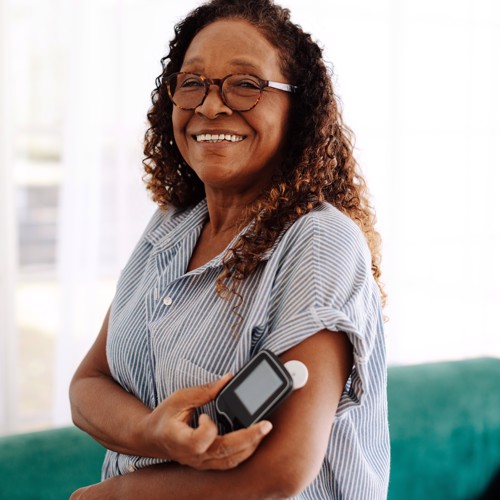Technology in diabetes, the future is bright
NO
PHARMACEUTICAL INFLUENCE
Technology in diabetes, the future is bright

Technology in diabetes, the future is bright
Flash glucose (intermittent scanning) and continuous glucose monitoring are increasingly around us and you may well have patients with diabetes asking if they are eligible for this technology. A very recent update to the NICE guidelines have extended eligibility, most notably for us in primary care to include access to flash glucose monitoring for some patients living with type 2 diabetes, as well as type 1.
So what do we need to know?
What is flash glucose monitoring again?
Flash glucose monitors work via a sensor which sits on the person’s upper arm and monitors intestinal fluid blood glucose. The sensor can be scanned using a scanner, or smartphone and app. Freestyle Libre 2 is the most recent version available in the UK and allows alarms to be set for both high and low readings. The sensor will automatically measure glucose every 15 minutes, as well as when scanned, and can store up to 8 hours of data, so provides the full glucose profile for the preceding period as well as a predictions of rising or falling levels.
Who is eligible for flash glucose monitoring?
The NICE guidelines was updated in March 2022 to extend the eligibility to:
- All people with type 1 diabetes
- Adults with type 2 diabetes on multiple daily insulin injections if any of the following apply
- Recurrent or severe hypoglycaemia or hypo unawareness
- Any condition, including learning disability or cognitive impairment, which means they cannot self-monitor with a capillary blood glucose monitor
- They would be finger prick testing at least 8 times a day
- They need help from a care worker to finger prick test
In Wales, the guidance goes beyond this, with everyone who treated with insulin eligible for flash monitoring.
Should we be starting flash glucose monitoring in primary care?
This will depend on your local pathways, but the answer is probably, and if not now very likely in the near future. There is plenty of support for online training for patients in how to use the devices. The Diabetes Technology Network is a great source of information both for our patients and ourselves as HCPs, with lots of free videos to access. The pharmaceutical company also offer a lot of training and support.
Practices can choose to register as a linked practice for the system and, with patients consent, automatically view data on pretty graphs which are incredibly informative about glucose patterns during a 24 hours period – much better than a few random fingerpick readings on the back of an envelope.
What is the evidence of benefit?
A large UK based real world study has been published by the Association of British Clinical Diabetologists looking at outcomes from over 10000 adults in the UK with diabetes, mainly type 1, using freestyle libre. This demonstrated a mean reduction in HBA1c of 5.2mmol/mol and significantly reductions in hypoglycaemia, diabetes distress, paramedic call outs and hospital admissions.
Flash glucose monitoring is the tip of the iceberg for technology, particularly for type 1 diabetes management, with increased access to continuous glucose monitoring, insulin pumps, and the next step – a closed loop system essentially mimicking the job of a pancreas.
Come along to our Diabetes in Primary Care course on Saturday June 11th 2022 for a full update in diabetes management from diagnosis of all type of diabetes, treatment especially the new NICE guidelines for type 2 diabetes and an insulin safety update from Su Down, our fabulous Consultant DSN.
Dr Sarah Davies
9th June 2022
Join us at one of our upcoming courses or live webinars

Recent NB Blogs
Need an immediate update? – all our courses are available on demand
Did you find this useful?
You can quickly add CPD to your account by writing a reflective note about the Technology in diabetes, the future is bright post you've read.
Log in to your NB Dashboard and use the 'Add Reflective Note' button at the bottom of a blog entry to add your note.

